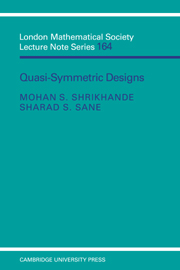Book contents
- Frontmatter
- Contents
- Preface
- Acknowledgments
- I Basic results from designs
- II Strongly regular graphs and partial geometries
- III Basic results on quasi-symmetric designs
- IV Some configurations related to strongly regular graphs and quasi-symmetric designs
- V Strongly regular graphs with strongly regular decompositions
- VI The Witt designs
- VII Extensions of symmetric designs
- VIII Quasi-symmetric 2-designs
- IX Towards a classification of quasi-symmetric 3-designs
- X Codes and quasi-symmetric designs
- References
- Index
VI - The Witt designs
Published online by Cambridge University Press: 05 May 2010
- Frontmatter
- Contents
- Preface
- Acknowledgments
- I Basic results from designs
- II Strongly regular graphs and partial geometries
- III Basic results on quasi-symmetric designs
- IV Some configurations related to strongly regular graphs and quasi-symmetric designs
- V Strongly regular graphs with strongly regular decompositions
- VI The Witt designs
- VII Extensions of symmetric designs
- VIII Quasi-symmetric 2-designs
- IX Towards a classification of quasi-symmetric 3-designs
- X Codes and quasi-symmetric designs
- References
- Index
Summary
In our earlier chapters, we have dealt somewhat at length with the questions of extensions and embeddings of (symmetric) designs, quasi-symmetric designs, and strongly regular graphs. The most elegant examples of these situations are provided by the Witt designs. Historically, statisticians were the first to make a systematic and exhaustive study of block designs, particularly from the point of view of constructions. However, block designs with regular and nice structural properties are generally obtained by making themselves available from groups. It is from this point of view that the (study of) Witt designs becomes extremely important. At present, there are at least two objects (excluding objects such as the Leech lattice) that are equivalent to Witt designs. These are the Golay codes (from coding theory) and the five Mathieu groups, all of which were the first examples of sporadic simple groups that have been completely determined now.
From the combinatorialist's point of view, a substantial portion of the research work in design theory centers around various characterizations of Witt designs by their properties. In this connection, also note that a result of Ito et al. and Bremner implies that the only non-trivial quasi-symmetric 4-design is the Witt 4-design or its complement. It has been conjectured that the only nontrivial quasi-symmetric 3-designs (other than the Hadamard 3-designs) are the 3-designs related to the Witt designs or their complements (see Chapter IX).
- Type
- Chapter
- Information
- Quasi-symmetric Designs , pp. 99 - 121Publisher: Cambridge University PressPrint publication year: 1991

